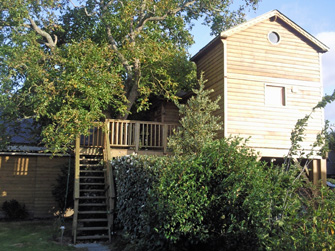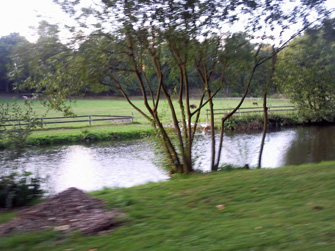 |
|
Angora goats at the Mohair du Pays du Corlay farm in Brittany. |
 |
|
Angora goats at the Mohair du Pays du Corlay farm in Brittany. |
Here’s a great vacation or weekend idea for those who like to get up close and personal with animals: a stay on a farm. On a recent visit to five agritourisme sites in Brittany, I had my legs lovingly rubbed by a flock of Angora goats, watched a sow give birth to piglets (not for those with a weak stomach, especially since this litter included a mummified fetus) and was shoved through a field by a friendly but scarily hefty Breton workhorse.
The idea of agritourism, which is big in France, Italy and many other European countries, is to give visitors a chance to observe life on a farm and sample local products (often homemade and organic) while offering small farmers a way to make some much-needed extra income.
Because this is France, you can be sure that the system is well-organized and regulated. An organization called Bienvenue à la Ferme, which lists 5,800 participating farms all over the country on its Web site, certifies that all its member farms practice sustainable, “responsible” agriculture and offer personalized visits to their farms. Those that receive overnight guests bed-and-breakfast-style must also be approved and rated by the reliable Gîtes de France http://www.gites-de-france.com/gites/fr/gites_ruraux system. All must be operational farms, not just showplaces.
The variety of sites and activities offered is vast, from sky-high tours of a farm in an ultralight to wine tasting or cooking classes, but this type of holiday may not be for everyone. Those who insist on luxury accommodations or who are allergic to kitsch should probably abstain. It is, however, highly recommended for families. What kid wouldn’t want to pet the soft fur of those Angora goats? And parents can use piglet-birthing as the basis for a discussion of the reproduction process and recover by tasting the local cider or wine. The accommodations can be highly original – roulottes (wooden trailers outfitted with all the amenities) and tree houses are especially popular.
 |
|
An Angora kid at the Mohair du Pays du Corlay farm. |
Not all the farms offer B&B facilities: some have campsites, while others give educational tours and/or sell their own products. At the farm where I met the Angora goats, for example, Mohair du Pays du Corlay, owners Anne-Marie and Bernard Charles explain the entire process of raising the goats and transforming their coats into mohair, and sell everything from mohair socks and slippers to blankets and sweaters made from their goat hair in their on-site boutique. Visitors also get to meet the goats, of course.
 |
|
A tree house at Les Fermes de Kerbalan. |
 |
|
Brigitte Vincent with some of the animals at Les Fermes de Kerbalan. |
Others go all out to give visitors anything their hearts might desire. Les Fermes de Kerbalan has not only an indoor swimming pool with large windows looking out onto a field with grazing cows, but also a sauna and Jacuzzi. Guests can sleep in roulottes, a tree house or ordinary guestrooms. Choose your rooms carefully here, since the kitsch level can be high, with a garish color combination in one room, lamps made out of painted riding boots in a horse-themed suite with a wooden bathtub, and stuffed animals everywhere. Owner Brigitte Vincent’s friendly enthusiasm triumphs over these small objections, however. Like all the others I met, she seems to love what she does and shows a genuine affection for the animals on her farm, even those that will someday end up on the dinner table (the piglets mentioned above).
 |
|
Donkeys dine next to the guests at the Ferme de Croas Men. |
 |
|
An original sculpture by the owner of the Ferme de Croas Men. |
The individual touch is in full evidence at the Cotty family’s Ferme de Croas Men), a campground is like no other you have seen. Yes, it has spacious green plots for tents and trailers, as well as cute little individual cabins and a couple of roulottes for rent, but it also has quite a few strange constructions and monumental sculptures built by Mr. Cotty, who grew up on the dairy farm and has now decorated the grounds with his artistic creations. He also has an instinct for preservation. The house he grew up in, now used as the breakfast room, has been kept as it was when his parents moved into a larger house next door at the end of World War II. A fire burns in the large chimney, and a box bed in the corner next to it is curtained for extra warmth and privacy. Antique machinery, some of it still in working order, and tools fill the barn, where Mr. Cotty is likely to start up a Jean Tinguely-like contraption he has built and tell a ghost story based on his childhood in the old house, guaranteed to give the kids nightmares.
 |
|
Goats at the Chèvrerie de Baradozic. |
Unlike the Cotty family, Eric and Gwenaëlle Sassower at the Chèvrerie de Baradozic are newcomers to farming. A few years ago Eric gave up his job as a manager for a waste-management company to make goat cheese. How did the couple learn their new trade? On the Internet, since they discovered that the local goat farmers weren’t willing to share their expertise with an outsider. Only three years later, they now have 120 goats and a thriving cheese business. Gwenaëlle recently opened a shop to sell the produce from her organic garden, and the couple offers educational visits to their farm, where these animal-loving dropouts from the corporate world also breed show rabbits and keep a few Breton work horses, one of which they rescued from being sent to the glue factory.
 |
|
Some of the scenery at the Ferme Auberge au Char à Bancs. |
More classic B&B style is the Ferme Auberge au Char à Bancs, a family affair run by succeeding generations of the Lamour family for four decades. In a gorgeous setting by a river, a mill is used to generate electricity for the whole establishment, which includes a rustic restaurant serving local specialties: homemade potée (a hearty slow-cooked dish made with the farm’s own sausages and pork, cabbage, potatoes and carrots), crêpes and cider. Below the restaurant is a shop filled with country antiques, especially dishes. Up on the hill, flanked by tall trees, including a 600-year-old sweet chestnut, are the guestrooms and apartments, all individually decorated with antiques mixed with modern furniture by founder’s daughter Céline.
What is really quite touching about these places is their total individuality (and sometimes eccentricity) and the way the owners seem to really love what they are doing and showing it off to visitors. All of those I visited were family affairs, with several generations working together on some. And I got to taste some great products, from the potée, homemade crêpes and cider to goat cheese and garden tomatoes. Visit the Bienvenue à la Ferme site for info on all the sites around France.
Reader Reaction
Click here to respond to this article (your response may be published on this page and is subject to editing).
© 2009 Paris Update
Favorite